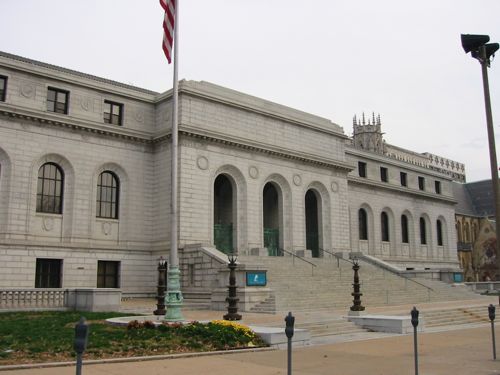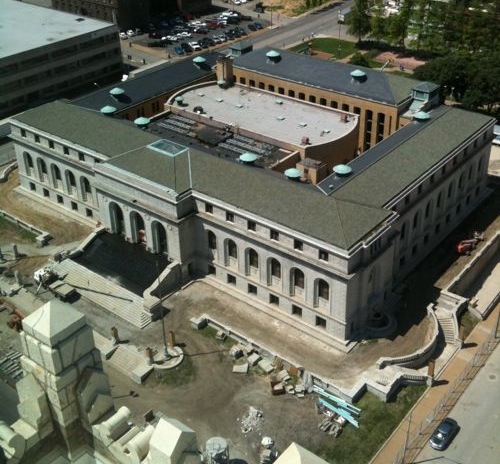St. Louis Central Library Opened 100 Years Ago Today
Saturday January 6, 1912 a new library opened for the citizens of St. Louis. The St. Louis Library was started in 1865 and was located in various buildings until this structure opened a century ago.

The site contained a building, less than 30 years old, that was razed for the library:
The Central Library building at 13th and Olive was built in 1912 on a location formerly occupied by the St. Louis Exposition and Music Hall and was designed by Cass Gilbert. The main library for the city’s public library system has an oval central pavilion surrounded by four light courts. The outer facades of the free-standing building are of lightly rusticated Maine granite. The Olive Street front is disposed like a colossal arcade, with contrasting marble bas-relief panels. A projecting three-bay central block, like a pared-down triumphal arch, provides a monumental entrance. At the rear, the Central Library faces a sunken garden. The interiors feature some light-transmitting glass floors. The ceiling of the Periodicals Room is modified from Michelangelo’s ceiling in the Laurentian Library. Renovation and expansion of the building began in 2010 and is scheduled to finish in 2012 (Wikipedia)
The library is a complex building as described above and as seen below.

The library closed in mid-2010 to undergo an extensive top to bottom renovation (see Beacon story w/video). The library will reopen later this year, most likely in the fall.They’ve put together a great website on the history of the building and the renovation plans, click here to view (highly recommended).
Prior to the closure the administrative offices moved to a newer building across 14th Street, freeing up more space for public use.

I live two blocks west of the library, I can’t wait for it to reopen.
– Steve Patterson
This again reinforces how arbitrary and capricious an “historic” designation can be, as well as how insane we’ve apparently been, for over a century, in building sports facilities here. When one clicks on the link for the St. Louis Exposition and Music Hall, one finds that before the current library structure was constructed, “Three national nominating conventions [two Democratic and one Republican] were held [here, and] it was used as a large venue for other conventions and congresses during the 1904 World’s Fair.” And, in 1897, “a new Coliseum was built on the site of the Exposition Building. . . The seating capacity was 7,000 but could be expanded to 12,000. . . The whole structure including the new Coliseum and Music Hall were torn down in 1907” (only 10 years later!) to build he current library structure.
Don’t get me wrong, I’m not questioning the current historic status of the existing library structure. My only point is that a lot of history preceeded the library’s location on this site. It also illustrates how a thriving city (which St. Louis was, a century ago) was willing to look forward, instead of looking so much at the past, including replacing structures that included much recent history. History has its place, but it shouldn’t be used to stymie every attempt at reinvesting in and reinventing our city for the 21st Century . . . .
This again reinforces how arbitrary and capricious an “historic” designation can be, as well as how insane we’ve apparently been, for over a century, in building sports facilities here. When one clicks on the link for the St. Louis Exposition and Music Hall, one finds that before the current library structure was constructed, “Three national nominating conventions [two Democratic and one Republican] were held [here, and] it was used as a large venue for other conventions and congresses during the 1904 World’s Fair.” And, in 1897, “a new Coliseum was built on the site of the Exposition Building. . . The seating capacity was 7,000 but could be expanded to 12,000. . . The whole structure including the new Coliseum and Music Hall were torn down in 1907” (only 10 years later!) to build he current library structure.
Don’t get me wrong, I’m not questioning the current historic status of the existing library structure. My only point is that a lot of history preceeded the library’s location on this site. It also illustrates how a thriving city (which St. Louis was, a century ago) was willing to look forward, instead of looking so much at the past, including replacing structures that included much recent history. History has its place, but it shouldn’t be used to stymie every attempt at reinvesting in and reinventing our city for the 21st Century . . . .
I agree JZ. And there are some today that would say the money would have been better spent tearing down the library and rebuilding for something more modern. It all goes to show that ‘historic’ is much in the eye of the beholder.
I agree JZ. And there are some today that would say the money would have been better spent tearing down the library and rebuilding for something more modern. It all goes to show that ‘historic’ is much in the eye of the beholder.
I find the library’s planned expansion to be pretty odd and uninspiring. There’s going to be a humongous open multi-story atrium on the new north entrance. This means – if I understand the plans correctly – that most of the new reading, work, and play spaces will NOT have windows facing the outside world: no natural light, no views of the surroundings. Even in the renderings, the spaces look gloomy and oppressive. The children’s library doesn’t seem to be any improvement over the old space.
It’s also not clear to me whether the existing south entrance is going to remain open. There’s been a trend in St. Louis to turn the wonderful front doors of the past into purely ornamental “statements.” In the end, we have faux grandeur in the back of the building, while a truly elegant, classic front porch gets moth balled.
Last point: why can’t they plant trees on the sides and in front? It’s so stark. If memory serves, it gets rather hot here in summer….
I find the library’s planned expansion to be pretty odd and uninspiring. There’s going to be a humongous open multi-story atrium on the new north entrance. This means – if I understand the plans correctly – that most of the new reading, work, and play spaces will NOT have windows facing the outside world: no natural light, no views of the surroundings. Even in the renderings, the spaces look gloomy and oppressive. The children’s library doesn’t seem to be any improvement over the old space.
It’s also not clear to me whether the existing south entrance is going to remain open. There’s been a trend in St. Louis to turn the wonderful front doors of the past into purely ornamental “statements.” In the end, we have faux grandeur in the back of the building, while a truly elegant, classic front porch gets moth balled.
Last point: why can’t they plant trees on the sides and in front? It’s so stark. If memory serves, it gets rather hot here in summer….
“And there are some today that would say the money would have been
better spent tearing down the library and rebuilding for something more
modern. It all goes to show that ‘historic’ is much in the eye of the
beholder. ”
Like a parking lot?
“And there are some today that would say the money would have been
better spent tearing down the library and rebuilding for something more
modern. It all goes to show that ‘historic’ is much in the eye of the
beholder. ”
Like a parking lot?
Nobody’s proposing a parking lot here.
The whole presrevation discussion centers around two or three main areas. One, every old structure and neighborhood has a history. It may be pretty mundane or it may be important, but stuff has happened over the years. Does that “history” trump making (any?) changes to the structure or neighborhood? Or not? Including tearing it down and starting over?
Two, when does history shift from being important to being unimportant? There’s consensus that most structures (that have survived) from the 18th and 19th centuries are important and probably should be saved, if possible, There also seems to be agreement that many structures from the first half of the 20th century are important, as well, at least up through the 1930’s or the 1940’s. Where things start to get fuzzy is after WW II, into the 1950’s, and the 1960’s and 1970’s seem to be highly suspect in many preservationists’ eyes. What’s the tipping point? If we can remember the time the building was built, does it become somehow less important or historic?
And three, how does one successfully preserve “history”? Do we create museums and freeze buildings and neighborhoods at some arbitrary point in time (1920?)? Do we allow changes to facilitate (sympathetic?) reuse? Do we force new construction look old? Or, do we just require similar materials and massing? And how do we integrate modern transportation choices?
The new addition to the library will present a stark visual contrast to the existing structure, and it will reorient how the structure is used, both internally and externally. We will all have our opinions. The big thing, to me at least, is that it’s being “saved” AND being reused. Hopefully, it will serve us well for another century.
Nobody’s proposing a parking lot here.
The whole presrevation discussion centers around two or three main areas. One, every old structure and neighborhood has a history. It may be pretty mundane or it may be important, but stuff has happened over the years. Does that “history” trump making (any?) changes to the structure or neighborhood? Or not? Including tearing it down and starting over?
Two, when does history shift from being important to being unimportant? There’s consensus that most structures (that have survived) from the 18th and 19th centuries are important and probably should be saved, if possible, There also seems to be agreement that many structures from the first half of the 20th century are important, as well, at least up through the 1930’s or the 1940’s. Where things start to get fuzzy is after WW II, into the 1950’s, and the 1960’s and 1970’s seem to be highly suspect in many preservationists’ eyes. What’s the tipping point? If we can remember the time the building was built, does it become somehow less important or historic?
And three, how does one successfully preserve “history”?  Do we create museums and freeze buildings and neighborhoods at some arbitrary point in time (1920?)? Do we allow changes to facilitate (sympathetic?) reuse? Do we force new construction look old? Or, do we just require similar materials and massing? And how do we integrate modern transportation choices?
The new addition to the library will present a stark visual contrast to the existing structure, and it will reorient how the structure is used, both internally and externally. We will all have our opinions. The big thing, to me at least, is that it’s being “saved” AND being reused. Hopefully, it will serve us well for another century.
I was surprised to learn there is a live spring in the basement that goes right into the sewer. Saw it on Living St. Louis.Â
I was surprised to learn there is a live spring in the basement that goes right into the sewer. Saw it on Living St. Louis.